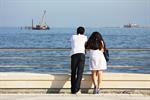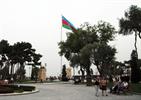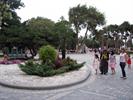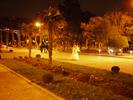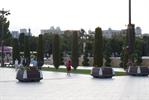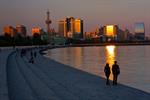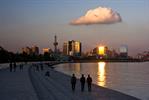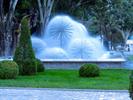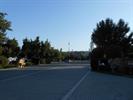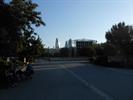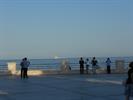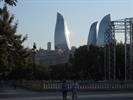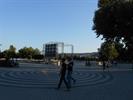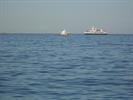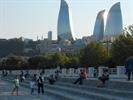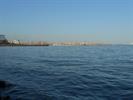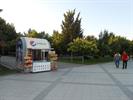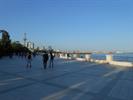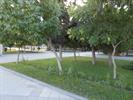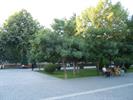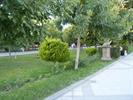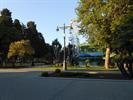The Boulevard along the Caspian is a beautiful, several kilometer long parkway that is a real gem of the city. Baku Boulevard (also known as National Park) is a promenade established in 1909 which runs parallel to Baku's seafront. Its history goes back more than 100 years, to a time when Baku oil barons built their mansions along the Caspian shore and when the seafront was artificially built up inch by inch.
The park is about 3 km and 750 m in size and located in south coast of the Caspian Sea. It starts at the National Flag Square and ends at Freedom Square. According to the Azerbaijan Cabinet of Ministers, the boulevard's size is expected to reach 26 km, which will cover areas including Bibiheyb?t and Bay of Baku by 2015.
The project on expansion of the Baku boulevard aims at creating more comfortable conditions for the residents of the capital city and the guests to have a rest and take sports in more comfortable conditions at the Caspian seashore. Before the Eurovision Song Contest 2012 the boulevard was extended to the National Flag Square.
HISTORY
Imperial Russian and Azerbaijan Democratic Republic Eras
The boulevard was established to connect the oilfields in Bibi Heybet as part of the urban development projects by Municipal Horticultural Commission.
In 1900, the Municipal Horticultural Commission decided to plant trees and shrubs along the seafront. Kazimierz Skurewicz, a Polish engineer, designed a 20-meter-wide embankment, using vegetation that would survive Baku's extremely hot, dry and gusty climate.
In 1909, Mammad Hassan Hajinski, Head of Baku's Municipal Construction Department improved the park by spending 60,000 rubles after Duma passed his resolution. The park was intended to provide for the continued expansion of the city to the north, providing relaxation and recreation opportunities for the new middle class to the west, and an escape from the rapid slumming of the city centre for those left behind. To select the best design for the Boulevard, Hajinski organized a contest among the architects in Baku. However, since most of the city's 30 architects were busy designing mansions for oil barons, only three submitted plans for it. The winning design was titled "Zvezda" (Star) and featured a bathing house, luxurious restaurant and a dozen pavilions. The design specified that wastewater would be collected in a separate manifold instead of being discharged directly into the Caspian (which is the case today). Work was completed in 1911.
Until the early 20th century, the avenue had mansions on one side and seafront on the other. There were no trees. Tons and tons of fertile soil were imported to enrich the soil quality. Baku's Mayor, R. R. Hoven, supported by the richest industrialists, passed a decree in the 1880s saying that all ships entering Baku harbors from Iran had to bring fertile soil with them. In reality, this was a kind of "tax" or "duty" imposed for the right to use the harbor and load up with oil. Within a very short time, enough soil was deposited, and the parks that characterize the city's seafront today were developed.
At the new Baku Bathing House, visitors could take a swim while visiting the Boulevard. This bathing house was closed in the late 1950s due to poor maintenance and the bay's polluted water.
The improved Boulevard stretched from what is now the SOCAR Circle to the luxurious cinema, restaurant and the casino that was called "Phenomenon", designed by Polish architect Jo'zef Plos'ko in 1912.
Soviet Period
During the Soviet period, the casino was converted to a Puppet Theater, a function it still serves today. Subsequently, the Boulevard was extended up to the Baku International Sea Trade Port. In the 1980s, the area was mismanaged and maintenance was neglected. The situation further deteriorated as the level of the sea began to rise so high that many of the trees and shrubs in the park started dying off due to the salinity of the water. At present, once again, the Caspian sea level is going back down.
In 1936, a parachute tower was built and used for extreme activities. However, the tower was turned into a weather forecast table after a fatal accident in the 1960s, which led to the ultimate ban of parachuting from the tower. To this day, the tower is considered one of the landmarks of the boulevard.
The Boulevard developed further after the construction of Bahar and Mirvari cafes, summer cinema and other leisure attractions during 1950-1960s.
In 1970, the boulevard was expanded to both eastward and westward.
Post-Independence
In 1999, the boulevard was proclaimed a National Park by Heydar Aliyev, former president of Azerbaijan. This status also helped to mitigate the environmental concerns such as cleanup of oil pollution from Caspian Sea oilfields. Until 2009, there were 28 entertainment attractions in boulevard's amusement park. However, due to safety reasons, old attractions were replaced by new carousels and rides from Italy and Germany.
The boulevard contains an amusement park, yacht club and musical fountain, and various statues and monuments. The park is popular with dog-walkers and joggers, and is convenient for tourists, being adjacent to newly built International Center of Mugham and musical fountain.
The boulevard marked it is 100th anniversary in 2009 as the specific date of it is creation is still unknown.
If you're planning a trip to Baku you may need: 1) A wide selection of accommodation options in Baku (basic hostels, budget hotels for unpretencious travelers, small size family run hotels, international business hotel chains). 2) Practical information for tourists (visa regime, prices, best time to vizit and etc). Please do not hesitate to contact us for consultation




